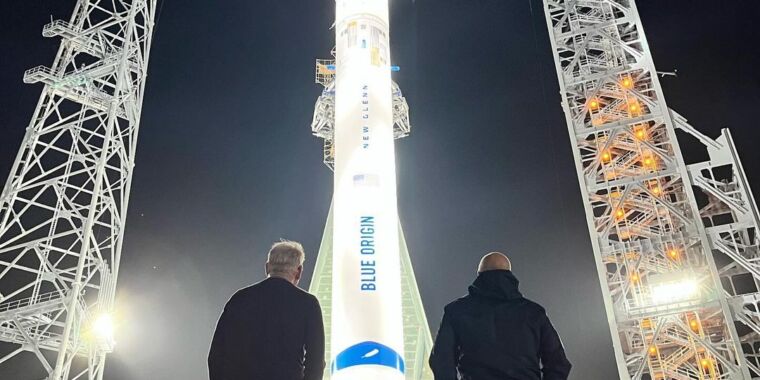Jeff Bezos’ New Glenn rocket finally makes an appearance on the launch pad


Anyone who has tracked the development of Blue Origin’s New Glenn rocket has been waiting for signs of progress from the usually secretive space company. On Wednesday, engineers rolled a full-scale New Glenn rocket, partially made up of flight hardware, to a launch pad in Florida for ground testing.
The first New Glenn launch is almost certainly at least six months away, and it may not even happen this year. In the last few years, observers inside and outside the space industry have become accustomed to the nearly annual ritual of another New Glenn launch delay. New Glenn’s inaugural flight has been delayed from 2020 until 2021, then 2022, and for now, is slated for later this year.
But it feels different now. Blue Origin is obviously moving closer to finally launching a rocket into orbit.
Scaling up
Jeff Bezos, Blue Origin’s founder, was at Cape Canaveral to see his giant new rocket on the launch pad for the first time. “Just incredible to see New Glenn on the pad at LC-36,” Bezos wrote on Instagram. “Big year ahead. Let’s go!”
Starting late last year, Blue Origin officials doubled down on the company’s plans to launch the first New Glenn test flight by the end of 2024. This messaging coincided with the arrival of Dave Limp as Blue Origin’s chief executive, replacing Bob Smith, whose seven-year tenure included the first human suborbital flights on the company’s New Shepard rocket. Smith’s time as CEO was also marked by repeated delays on the New Glenn rocket.
Limp is pushing Blue Origin to move faster, and it seems the company’s employees got the memo. In December, the company rolled elements of the New Glenn rocket from its factory just outside the gates of NASA’s Kennedy Space Center to a final assembly hangar located about nine miles away at Cape Canaveral Space Force Station.
Inside that building, technicians connected the first stage booster, which is flight hardware, with an upper stage Blue Origin has set aside for ground testing. The final piece of the rocket to be added was a 23-foot-diameter (7-meter) payload fairing, the uppermost section of New Glenn designed to protect spacecraft during the initial phase of launch.
Last week, Blue Origin lifted a structure simulating the rocket’s empty mass vertical using the transporter-erector arm at Launch Complex 36 (LC-36), a former Atlas launch pad Blue Origin took over in 2015. This was a final validation of the lifting arm at LC-36 before Blue Origin put a real, or mostly real, rocket on the pad.

On Wednesday, ground crews rolled a fully assembled New Glenn rocket out of the hangar at LC-36 and up the ramp to the launch mount. Then, the hydraulic lifting arm raised the two-stage launcher vertically. At more than 320 feet (98 meters) tall, New Glenn is one of the largest rockets ever seen on Florida’s Space Coast, roughly the same height as NASA’s Space Launch System rocket and nearly as tall as the Saturn V used in the Apollo program.
“The upending is one in a series of major manufacturing and integrated test milestones in preparation for New Glenn’s first launch later this year,” Blue Origin officials wrote in an update on Wednesday. “The test campaign enables our teams to practice, validate, and increase proficiency in vehicle integration, transport, ground support, and launch operations.”
New Glenn can haul nearly 100,000 pounds (45 metric tons) of payload into low-Earth orbit. For low-altitude orbits, this is a weight class above the uppermost capability of United Launch Alliance’s Vulcan rocket or SpaceX’s Falcon 9 rocket but below SpaceX’s Falcon Heavy. Blue Origin also plans to use the New Glenn rocket to launch lunar landers to the Moon for NASA’s Artemis program.
New Glenn’s first stage booster is reusable, and is designed to land on an offshore barge in the Atlantic Ocean, which will bring it back to the coast, similar to the way SpaceX recovers its Falcon 9 booster.
“The fairing is large enough to hold three school buses,” Blue Origin said. “Its reusable first stage aims for a minimum of 25 missions and will land on a sea-based platform located roughly 620 miles (1,000 kilometers) downrange.”
Blue Origin is now 24 years old and employs around 11,000 people at locations around the country, with major locations in Washington, Texas, Florida, and Alabama. While the company has not yet launched anything into orbit, Blue Origin is working on a wide range of projects aside from rockets, including cargo and human-rated lunar landers for NASA and a space tug that could move payloads into different orbits for the US military. New Glenn is crucial for all of these plans.
Blue Origin’s latest progress with New Glenn comes as Bezos’s space company appears to be on the verge of buying United Launch Alliance from Boeing and Lockheed Martin.




